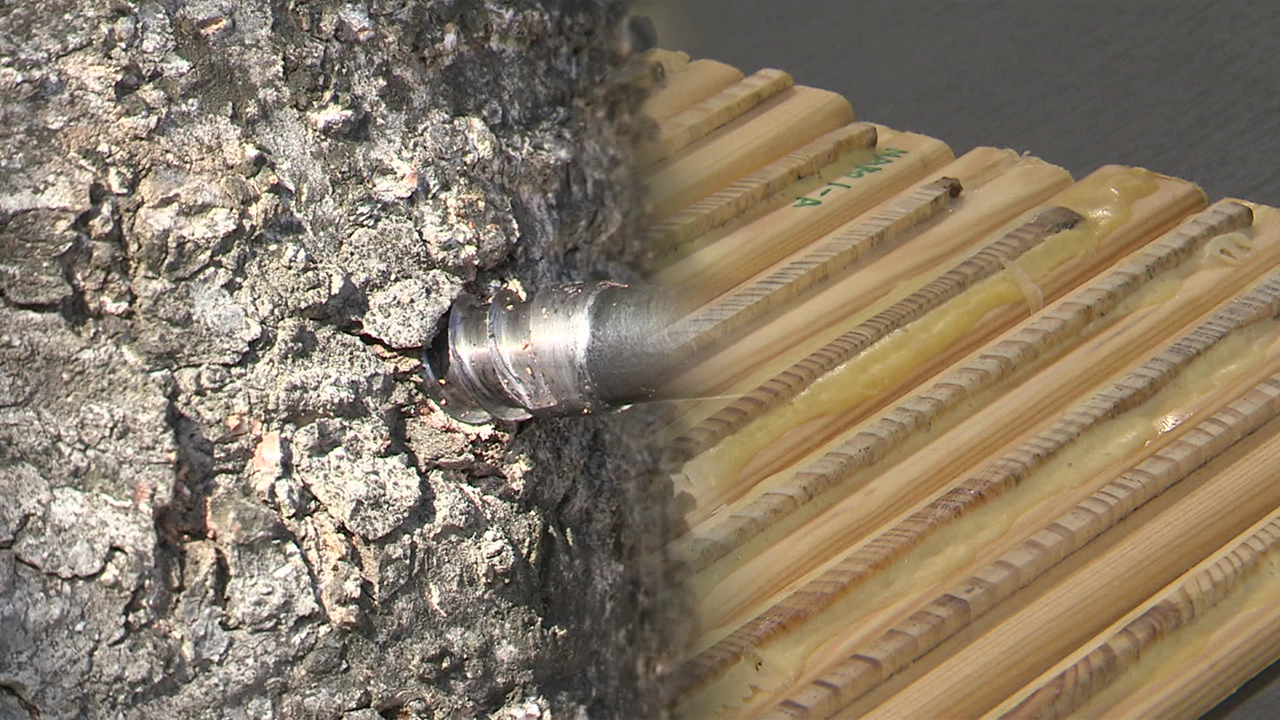Tree rings reveal 370 years of climate change on the Korean Peninsula
입력 2024.10.30 (23:46)
읽어주기 기능은 크롬기반의
브라우저에서만 사용하실 수 있습니다.
[Anchor]
The tree rings are referred to as a climate black box as they are used to study past temperatures and precipitation.
Recently, domestic researchers analyzed the climate of Korea over the longest period of 370 years through the tree rings of the pine trees in Seoraksan.
What changes were observed? Our meteorology specialist Shin Bang-sil reports.
[Report]
Tree rings are engraved on a wooden stick.
These are the tree rings collected from the tree line of Seoraksan, where human foot traffic is rare.
A tree ring is formed once a year, and the width varies as the growth rate of the tree changes depending on temperature and precipitation.
Based on this, it is possible to study past climates, which is why it is called a 'climate black box.'
[Kim Min-seok/Researcher, Department of Environment, Energy, and Geoinformatics, Sejong University: "The wider the tree ring, the better the growth, and the density indicates that it has grown densely."]
Domestic researchers analyzed climate changes on the Korean Peninsula over approximately 370 years through the tree rings of Seoraksan pine trees.
The growth of Seoraksan pine trees was observed to be extremely suppressed until 1750.
This is presumed to be due to the Little Ice Age, which peaked in the 17th century.
In fact, historical records from the Annals of the Joseon Dynasty indicate that the usually unfrozen East Sea froze over during that time.
As we approached the 2000s, the growth rate of the pine trees gradually increased, growing at the largest rate in over 300 years.
This reflects the warming trend of the Korean Peninsula, which has increased by 1.8 degrees over the past century.
[Jung Ji-hoon/Professor, Department of Environment, Energy, and Geoinformatics, Sejong University: "This is a very long dataset that allows us to understand how strongly climate change has occurred and how much plants are responding to this climate change."]
The research team plans to incorporate the results of this study into climate prediction models to enhance their accuracy.
This is KBS News, Shin Bang-sil reporting.
The tree rings are referred to as a climate black box as they are used to study past temperatures and precipitation.
Recently, domestic researchers analyzed the climate of Korea over the longest period of 370 years through the tree rings of the pine trees in Seoraksan.
What changes were observed? Our meteorology specialist Shin Bang-sil reports.
[Report]
Tree rings are engraved on a wooden stick.
These are the tree rings collected from the tree line of Seoraksan, where human foot traffic is rare.
A tree ring is formed once a year, and the width varies as the growth rate of the tree changes depending on temperature and precipitation.
Based on this, it is possible to study past climates, which is why it is called a 'climate black box.'
[Kim Min-seok/Researcher, Department of Environment, Energy, and Geoinformatics, Sejong University: "The wider the tree ring, the better the growth, and the density indicates that it has grown densely."]
Domestic researchers analyzed climate changes on the Korean Peninsula over approximately 370 years through the tree rings of Seoraksan pine trees.
The growth of Seoraksan pine trees was observed to be extremely suppressed until 1750.
This is presumed to be due to the Little Ice Age, which peaked in the 17th century.
In fact, historical records from the Annals of the Joseon Dynasty indicate that the usually unfrozen East Sea froze over during that time.
As we approached the 2000s, the growth rate of the pine trees gradually increased, growing at the largest rate in over 300 years.
This reflects the warming trend of the Korean Peninsula, which has increased by 1.8 degrees over the past century.
[Jung Ji-hoon/Professor, Department of Environment, Energy, and Geoinformatics, Sejong University: "This is a very long dataset that allows us to understand how strongly climate change has occurred and how much plants are responding to this climate change."]
The research team plans to incorporate the results of this study into climate prediction models to enhance their accuracy.
This is KBS News, Shin Bang-sil reporting.
■ 제보하기
▷ 카카오톡 : 'KBS제보' 검색, 채널 추가
▷ 전화 : 02-781-1234, 4444
▷ 이메일 : kbs1234@kbs.co.kr
▷ 유튜브, 네이버, 카카오에서도 KBS뉴스를 구독해주세요!
- Tree rings reveal 370 years of climate change on the Korean Peninsula
-
- 입력 2024-10-30 23:46:08

[Anchor]
The tree rings are referred to as a climate black box as they are used to study past temperatures and precipitation.
Recently, domestic researchers analyzed the climate of Korea over the longest period of 370 years through the tree rings of the pine trees in Seoraksan.
What changes were observed? Our meteorology specialist Shin Bang-sil reports.
[Report]
Tree rings are engraved on a wooden stick.
These are the tree rings collected from the tree line of Seoraksan, where human foot traffic is rare.
A tree ring is formed once a year, and the width varies as the growth rate of the tree changes depending on temperature and precipitation.
Based on this, it is possible to study past climates, which is why it is called a 'climate black box.'
[Kim Min-seok/Researcher, Department of Environment, Energy, and Geoinformatics, Sejong University: "The wider the tree ring, the better the growth, and the density indicates that it has grown densely."]
Domestic researchers analyzed climate changes on the Korean Peninsula over approximately 370 years through the tree rings of Seoraksan pine trees.
The growth of Seoraksan pine trees was observed to be extremely suppressed until 1750.
This is presumed to be due to the Little Ice Age, which peaked in the 17th century.
In fact, historical records from the Annals of the Joseon Dynasty indicate that the usually unfrozen East Sea froze over during that time.
As we approached the 2000s, the growth rate of the pine trees gradually increased, growing at the largest rate in over 300 years.
This reflects the warming trend of the Korean Peninsula, which has increased by 1.8 degrees over the past century.
[Jung Ji-hoon/Professor, Department of Environment, Energy, and Geoinformatics, Sejong University: "This is a very long dataset that allows us to understand how strongly climate change has occurred and how much plants are responding to this climate change."]
The research team plans to incorporate the results of this study into climate prediction models to enhance their accuracy.
This is KBS News, Shin Bang-sil reporting.
The tree rings are referred to as a climate black box as they are used to study past temperatures and precipitation.
Recently, domestic researchers analyzed the climate of Korea over the longest period of 370 years through the tree rings of the pine trees in Seoraksan.
What changes were observed? Our meteorology specialist Shin Bang-sil reports.
[Report]
Tree rings are engraved on a wooden stick.
These are the tree rings collected from the tree line of Seoraksan, where human foot traffic is rare.
A tree ring is formed once a year, and the width varies as the growth rate of the tree changes depending on temperature and precipitation.
Based on this, it is possible to study past climates, which is why it is called a 'climate black box.'
[Kim Min-seok/Researcher, Department of Environment, Energy, and Geoinformatics, Sejong University: "The wider the tree ring, the better the growth, and the density indicates that it has grown densely."]
Domestic researchers analyzed climate changes on the Korean Peninsula over approximately 370 years through the tree rings of Seoraksan pine trees.
The growth of Seoraksan pine trees was observed to be extremely suppressed until 1750.
This is presumed to be due to the Little Ice Age, which peaked in the 17th century.
In fact, historical records from the Annals of the Joseon Dynasty indicate that the usually unfrozen East Sea froze over during that time.
As we approached the 2000s, the growth rate of the pine trees gradually increased, growing at the largest rate in over 300 years.
This reflects the warming trend of the Korean Peninsula, which has increased by 1.8 degrees over the past century.
[Jung Ji-hoon/Professor, Department of Environment, Energy, and Geoinformatics, Sejong University: "This is a very long dataset that allows us to understand how strongly climate change has occurred and how much plants are responding to this climate change."]
The research team plans to incorporate the results of this study into climate prediction models to enhance their accuracy.
This is KBS News, Shin Bang-sil reporting.
-
-

신방실 기자 weezer@kbs.co.kr
신방실 기자의 기사 모음
-
이 기사가 좋으셨다면
-
좋아요
0
-
응원해요
0
-
후속 원해요
0















이 기사에 대한 의견을 남겨주세요.